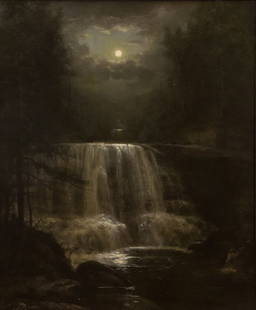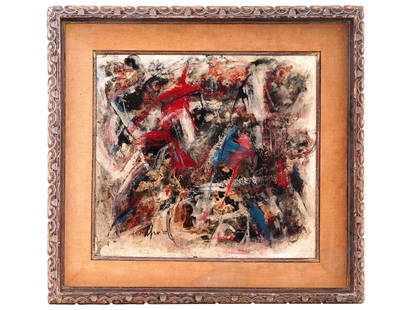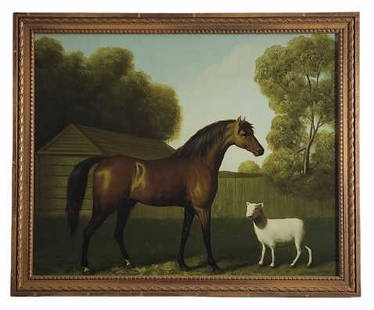
George Stubbs ARA (Liverpool 1724-1806 London) A black and white spaniel pointing to the left, i...
George Stubbs Sale History
View Price Results for George StubbsRelated Paintings
More Items in Gothic Paintings
View MoreRecommended Art
View More



Item Details
Description
George Stubbs ARA (Liverpool 1724-1806 London)
A black and white spaniel pointing to the left, in a wooded landscape with a church spire beyond
oil on canvas
54.4 x 73.2cm (21 7/16 x 28 13/16in).
Footnotes:
Stubbs was famously the most sought-after painter of horses by all those leading aristocrats of his day who had a passion for breeding and/or racing horses, so it was only inevitable that he was also commissioned to paint some of his patrons' favourite dogs. Alex Kidson has dated the present painting to the second half of the 1770s and the preponderance of Stubbs's exhibited portraits of dogs date from between 1772 and 1782, the bulk of them being shown at the Royal Academy, where he exhibited fifteen dogs of all kinds, largely pet dogs, probably all commissioned by private owners, culminating in the very large portrait of the Duke of York's Newfoundland Dog in 1803. Of these, his most frequent works were of pointers, setters and spaniels. These were all types that were not at that time categorised by their breeds as they are today, but for the most part were described by their sporting functions (making it difficult to identify the descriptions of those of Stubbs's dog portraits that were exhibited at the Royal Academy, with simple titles, such as Portrait of a Dog). In this case what is now recognised as a spaniel is in the act of 'pointing' at game, showing this sporting dog standing characteristically rigid as she scents a bird with muzzle stretched toward the game and one foot raised.
Amongst Stubbs's most comparable works are his Spaniel, which he painted for the artist's loyal patron, William Wildman and is thought to have been a companion to a Pointer, which is of similar dimensions, although the latter is on paper laid on panel. Being 61 x 71 cm. and on canvas, William Wildman's Spaniel is a very comparable example of Stubbs's works to the present painting (Collection of British Sporting Art Trust; see Judy Egerton, George Stubbs, Painter. Catalogue Raisonné, New Haven, 2007, 139 and 140, p. 332). Other similar portraits of dogs by Stubbs include a Black and white spaniel following a scent, dated 1771, which is on canvas and measures 59.5 x 70.8 cm. (Private Collection; see Egerton op. cit. no. 170, p. 370); Black and white spaniel following a scent, dated 1771, on canvas, 63.5 x 76.2 cm. (Virginia Museum of Fine Arts, Richmond; see Egerton op. cit., no. 171, p. 370); and Brown and white spaniel following a scent, dated 1777, on panel, 38.1 x 53.3 cm. (Private Collection, Egerton, op. cit., no. 172, p. 371).
Stubbs trained himself as an anatomist, having moved from Liverpool to York around 1745 in order to study in the city's hospitals. His drawings of dissections were then used to illustrate Dr. John Burton's Essay towards a Complete New System of Midwifery. He went on to study the physical structure and make-up of horses in order to ensure the accuracy of his paintings and the publication of his The Anatomy of the Horse in 1766 established his reputation. Queen Charlotte even commissioned him to paint her zebra – a remarkably exotic creature at the time, being the first of its kind to be seen in England, when it was installed in a paddock near the royal menagerie in Saint James's Park to 'entertain the populace' – a work that was subsequently sold at Bonhams (fig. 1). Other creatures that caught his attention were deer, a falcon, a monkey, lions, leopards, even a yak, a rhinoceros, a kangaroo and a dingo. It was in the mid-1760s that he turned his attention to dogs.
Unlike with his portraits of horses, whose long legs allowed him to fill the space between them with landscapes, the compact build of his dogs necessitated Stubbs to make them fully occupy their space and dominate their settings, as we see here. The present painting is also typical of his working methods in the way in which the exuberantly feathered tail (which he seems to have particularly delighted in painting) was portrayed against a plain and darker background. The background of the picture as a whole echoes those of an early series of portraits dating to the 1770s of black and white or brown and white pointers following a scent, with the backdrop of trees and ground falling away to give a glimpse of a distant church spire set against distant hills: no doubt a clue to the estate to which the dog belonged.
In Judy Egerton's words Stubbs was an artist with 'a deep and unaffected sympathy for the country life and English countryside.' In such a setting dogs were especially valued and beloved by both master and servant, where affection for a dog, in even the grandest of country estates, whether a working dog or a pet, was common to all classes of society. Such sensibilities were expressed by William Pitt the Elder when he counted the companionship of a dog as among 'the little-great pleasures of life'. Already common companions to be found in 16th and 17th century portraits of the grandest sitters by the greatest portrait painters, it was inevitable that with Stubbs dogs were to acquire the status of subjects in their own right, valued then as much as they are today.
We are grateful to Alex Kidson and Brian Allen for confirming the attribution of this painting to George Stubbs.
A black and white spaniel pointing to the left, in a wooded landscape with a church spire beyond
oil on canvas
54.4 x 73.2cm (21 7/16 x 28 13/16in).
Footnotes:
Stubbs was famously the most sought-after painter of horses by all those leading aristocrats of his day who had a passion for breeding and/or racing horses, so it was only inevitable that he was also commissioned to paint some of his patrons' favourite dogs. Alex Kidson has dated the present painting to the second half of the 1770s and the preponderance of Stubbs's exhibited portraits of dogs date from between 1772 and 1782, the bulk of them being shown at the Royal Academy, where he exhibited fifteen dogs of all kinds, largely pet dogs, probably all commissioned by private owners, culminating in the very large portrait of the Duke of York's Newfoundland Dog in 1803. Of these, his most frequent works were of pointers, setters and spaniels. These were all types that were not at that time categorised by their breeds as they are today, but for the most part were described by their sporting functions (making it difficult to identify the descriptions of those of Stubbs's dog portraits that were exhibited at the Royal Academy, with simple titles, such as Portrait of a Dog). In this case what is now recognised as a spaniel is in the act of 'pointing' at game, showing this sporting dog standing characteristically rigid as she scents a bird with muzzle stretched toward the game and one foot raised.
Amongst Stubbs's most comparable works are his Spaniel, which he painted for the artist's loyal patron, William Wildman and is thought to have been a companion to a Pointer, which is of similar dimensions, although the latter is on paper laid on panel. Being 61 x 71 cm. and on canvas, William Wildman's Spaniel is a very comparable example of Stubbs's works to the present painting (Collection of British Sporting Art Trust; see Judy Egerton, George Stubbs, Painter. Catalogue Raisonné, New Haven, 2007, 139 and 140, p. 332). Other similar portraits of dogs by Stubbs include a Black and white spaniel following a scent, dated 1771, which is on canvas and measures 59.5 x 70.8 cm. (Private Collection; see Egerton op. cit. no. 170, p. 370); Black and white spaniel following a scent, dated 1771, on canvas, 63.5 x 76.2 cm. (Virginia Museum of Fine Arts, Richmond; see Egerton op. cit., no. 171, p. 370); and Brown and white spaniel following a scent, dated 1777, on panel, 38.1 x 53.3 cm. (Private Collection, Egerton, op. cit., no. 172, p. 371).
Stubbs trained himself as an anatomist, having moved from Liverpool to York around 1745 in order to study in the city's hospitals. His drawings of dissections were then used to illustrate Dr. John Burton's Essay towards a Complete New System of Midwifery. He went on to study the physical structure and make-up of horses in order to ensure the accuracy of his paintings and the publication of his The Anatomy of the Horse in 1766 established his reputation. Queen Charlotte even commissioned him to paint her zebra – a remarkably exotic creature at the time, being the first of its kind to be seen in England, when it was installed in a paddock near the royal menagerie in Saint James's Park to 'entertain the populace' – a work that was subsequently sold at Bonhams (fig. 1). Other creatures that caught his attention were deer, a falcon, a monkey, lions, leopards, even a yak, a rhinoceros, a kangaroo and a dingo. It was in the mid-1760s that he turned his attention to dogs.
Unlike with his portraits of horses, whose long legs allowed him to fill the space between them with landscapes, the compact build of his dogs necessitated Stubbs to make them fully occupy their space and dominate their settings, as we see here. The present painting is also typical of his working methods in the way in which the exuberantly feathered tail (which he seems to have particularly delighted in painting) was portrayed against a plain and darker background. The background of the picture as a whole echoes those of an early series of portraits dating to the 1770s of black and white or brown and white pointers following a scent, with the backdrop of trees and ground falling away to give a glimpse of a distant church spire set against distant hills: no doubt a clue to the estate to which the dog belonged.
In Judy Egerton's words Stubbs was an artist with 'a deep and unaffected sympathy for the country life and English countryside.' In such a setting dogs were especially valued and beloved by both master and servant, where affection for a dog, in even the grandest of country estates, whether a working dog or a pet, was common to all classes of society. Such sensibilities were expressed by William Pitt the Elder when he counted the companionship of a dog as among 'the little-great pleasures of life'. Already common companions to be found in 16th and 17th century portraits of the grandest sitters by the greatest portrait painters, it was inevitable that with Stubbs dogs were to acquire the status of subjects in their own right, valued then as much as they are today.
We are grateful to Alex Kidson and Brian Allen for confirming the attribution of this painting to George Stubbs.
Buyer's Premium
- 15% up to £15,000.00
- 10% above £15,000.00
George Stubbs ARA (Liverpool 1724-1806 London) A black and white spaniel pointing to the left, i...
Estimate £200,000 - £300,000
52 bidders are watching this item.
Shipping & Pickup Options
Item located in London, England, ukOffers In-House Shipping
Local Pickup Available
Payment

TOP
































































